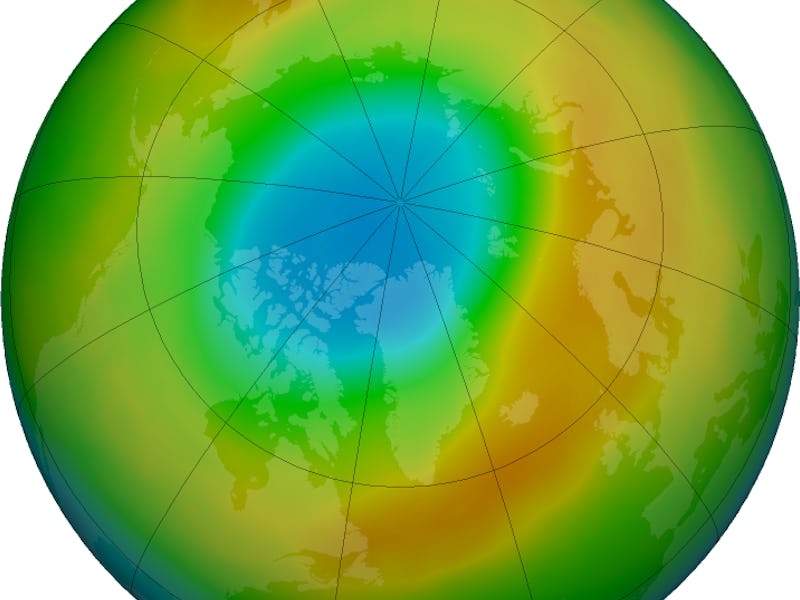Satellites spot the largest hole in the ozone layer over the Arctic ever recorded
This year's polar vortex may have opened up a 1 million square kilometer-sized hole over the Earth's North pole.

NASA and European Space Agency (ESA) satellites have spotted a hole in the planet's ozone layer above the Arctic that is set to be the largest of its kind ever detected.
The reason why may be due to extreme temperatures and unusual weather over the course of this year's winter at the Earth's North pole, according to new satellite data released by ESA.
In data taken by ESA’s Copernicus Sentinel-5P satellite, scientists spotted a strong reduction in ozone concentrations over the Arctic that began in the early months of 2020. At the beginning of April 2020, the hole had reached 1 million square kilometers in size.
Depletion in ozone over the Arctic is no surprise in and of itself. The atmosphere above the North and South poles loses ozone every year. The reason why is down to temperature: Extremely low temperatures cause clouds over the poles to form one mass, while chemicals such as chlorine and bromine, which stem from industrial sources, trigger reactions on the clouds that causes them to eat away at the protective ozone layer.
Over the Antarctic, extremely cold temperatures cause gigantic holes to form during winter. These holes can reach a size of around 20 to 25 million sq km, and last for around three to four months.
This year's Arctic hole is titchy compared to its Antarctic counterparts. But it is extremely unusual for the area. Temperatures in the Arctic don’t regularly drop as low as they do in Antarctica, which is why scientists don’t usually observe as much ozone depletion in the North pole.
But the scale of this hole is what is so shocking for scientists.
The ozone hole shown in blue above the Arctic in March, 2020.
To get a sense of how unusual the scale of the hole this year is, take a look at last year's satellite observations of the same area:
The same area above the Arctic, imaged in March, 2019.
The reason why may come down to temperature differences between our planet's poles.
To explain this year’s unusually large Arctic ozone hole, scientists turned to weather data, which suggests a 'polar vortex' may be to blame. These powerful wind systems trap cold air, essentially creating a whirlpool of stratospheric winds.
Scientists expect the large mini-hole to close up again by mid-April, 2020, according to ESA.
What is ozone? — The ozone layer acts like a shield surrounding Earth, protecting our planet from harmful ultraviolet radiation from the Sun.
Despite its unusual size and appearance, the Arctic ozone hole doesn't pose a threat to the planet at the moment, scientists say. That's because, as the Northern hemisphere transitions from winter to spring, the Sun is just starting to rise above the horizon in the polar regions, according to Nature. By the time it reaches higher altitudes and starts to shine more brightly on the North pole region, the ozone hole will likely by no more, scientists predict.
The ozone layer is also a measure of how much man-made pollution and industrialization affects our environment. And artificial holes in the ozone are major cause for concern. In 1987, the Montreal Protocol passed, banning the use of the harmful chemical chlorofluorocarbons in order to reduce their effects on the ozone layer. Since then, Earth's stratosphere had begun showing signs of recovery.
In fact, the 2019 ozone hole over Antartica was the smallest one on record.
But it is still unclear what this new record for the ozone hole above the Arctic means in terms of the long-term effectiveness of our efforts to mitigate the depletion of the ozone layer. Only time will tell if the larger hole is a one-off weather side effect or part of a larger, and worrying, trend.